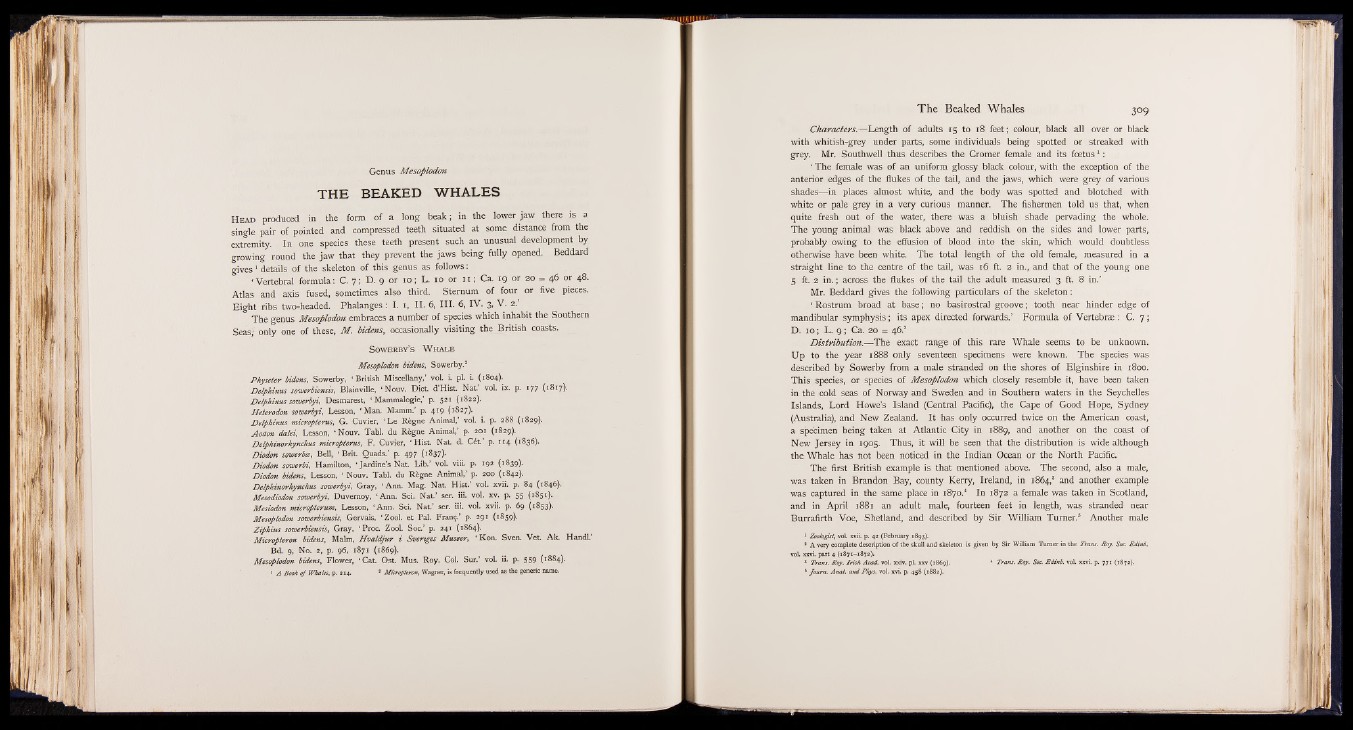
Genus Mesoplodon
T H E B EA K ED W H A L E S
Head produced in the form of a long beak ; in the lower jaw there is a
single pair of pointed and compressed teeth situated at some distance from the
extremity. In one species these teeth present such an unusual development by
growing round the jaw that they prevent the jaws being fully opene^Bedd ard
gives1 details ,of the skeleton. of this genus, a s , follows :
‘ Vertebral formula: C. 7; D. 9 or 10; L. 10 or 11 ; Ca. 19 or 20 = 46 or 48.
Atlas and axis fused, sometimes also third. Sternum of four or five pieces.
Eight ribs two-headed. Phalanges : I. 1, II. 6, III. 6, IV. 3, V. 2.’
The genus Mesoplodon embraces a number of species which inhabit the Southern
Seas; only one of these, M. bidens, occasionally visiting the British coasts.
S owerby’s W hale
Mesoplodon bidens, Sowerby.2
Physeter bidens, Sowerby, ‘ British Miscellany,’ vol. i. pi. i. (1804).
D elphinus sowerbiensis, Blainville, ‘ Nouv. D ie t d’H is t N a t vol. ix. p. 177 (1817).
D elphinus sowerbyi, Desmarest, ‘ Mammalogie,’ p. 521 (1822).
Heterodon sowerbyi, Lesson, ‘ Man. Mamm. p. 4I9 ( I^27)>
Delphinus microptems, G. Cuvier, ‘ L e Règne Animal, vol. i. p. 288 (1829).
Aodon dalei, Lesson, ‘ Nouv. Tabl. du Règne Animal,’ p. 201 (1829).
Delphinorhynchus microptems, F. Cuvier, ‘ H is t N a t d. C é t p. 114 (1836).
Diodon sowerbee, Bell, ‘ Brit. Quads.’ p. 497 (1837).
Diodon sowerbi, Hamilton, ‘ Jardine’s Nat. Lib.’ vol. viii. p. 192 (1839).
Diodon bidens. Lesson, ‘ Nouv. Tabl. du Règne Animal,’ p. 200 (1842).
Delphinorhynchus sowerbyi, Gray, ‘ Ann. Mag. Nat. Hist.’ vol. xvii. p. 84 (1846).
Mesodiodon sowerbyi, Duvemoy, ‘ Ann. Sci. N a t ’ ser. iii. vol. xv. p. 55 (1851).
Mesiodon micropterum, Lesson, ‘ Ann. Sci. Nat.’ ser. iii. vol. xvii. p. 69 (1853).
Mesoplodon sowerbiensis, Gervais, ‘ Zool. et Pal. Franç.’ p. 291 (1859).
Z ip h iu s sowerbiensis, Gray, ‘ Proc. Zool. Soc.’ p. 241 (1864).
Micropteron bidens, Malm, H vald ju r i Svenges M useer, ‘ Kon. Sven. Vet. Ak . Handl.’
Bd. 9, No. 2, p. 96, 1871 (1869).
Mesoplodon bidens, Flower, ‘ Cat. Ost. Mus. Roy. Col. Sur.’ vol. ii. p. 559 (1884).
J A Book o f Whales, p. 214. * Micropteron, Wagner, is frequently used as the generic name.
Characters.— Length of adults 15 to 18 feet; colour, black all over or black
with whitish-grey under parts, some individuals being spotted or streaked with
grey. Mr. Southwell thus describes the Cromer female and its foetus1 :
‘ The female was of an uniform glossy black colour, with the exception of the
anterior edges of the flukes of the tail, and the jaws, which were grey of various
shades— in places almost white, and the body was spotted and blotched with
white or pale grey in a very curious manner. The fishermen told us that, when
quite fresh out of the water, there was a bluish shade pervading the whole.
The young animal was black above and reddish on the sides and lower parts,
probably owing to the effusion of blood into the skin, which would doubtless
otherwise have been white. The total length of the old female, measured in a
straight line to the centre of the tail, was 16 ft. 2 in., and that of the young one
5 ft. 2 in .; across the flukes of the tail the adult measured 3 ft. 8 in.’
Mr. Beddard gives the following particulars of the skeleton:
‘ Rostrum broad at base; no basirostral groove; tooth near hinder edge of
mandibular symphysis; its apex directed forwards.’ Formula of Vertebrae : C. 7;
D. 10; L. 9 ; Ca. 20 = 46.2
Distribution.— The exact range of this rare Whale seems to be unknown.
Up to the year 1888 only seventeen specimens were known. The species was
described by Sowerby from a male stranded on the shores of Elginshire in 1800.
This species, or species of Mesoplodon which closely resemble it, have been taken
in the cold seas of Norway and Sweden and in Southern waters in the Seychelles
Islands, Lord Howe’s Island (Central Pacific), the Cape of Good Hope, Sydney
(Australia), and New Zealand. It has only occurred twice on the American coast,
a specimen being taken at Atlantic City in 1889, and another on the coast of
New Jersey in 1905. Thus, it will be seen that the distribution is wide although
the Whale has not been noticed in the Indian Ocean or the North Pacific.
The first British example is that mentioned above. The second, also a male,
was taken in Brandon Bay, county Kerry, Ireland, in 1864,8 and another example
was captured in the same place in 1870.4 In 1872 a female was taken in Scotland,
and in April 1881 an adult male, fourteen feet in length, was stranded near
Burrafirth Voe, Shetland, and described by Sir William Turner.® Another male
1 Zoologist, vol. xvii. p. 42 (February 1893).
2 A very complete description of the skull and skeleton is given by Sir William Turner in the Trans. Roy. Soc. Edinb.
vol. xxvi. part 4 (1871-1872).
1 Trans. Roy. Irish Acad. vol. xxiv. pi. xxv (1869).
® Joum. Anat. and Rhys. vol. xvi. p. 458 (1882).
4 Trans. Roy. Soc. Edinb. vol. xxvi. p. 771 (1872).